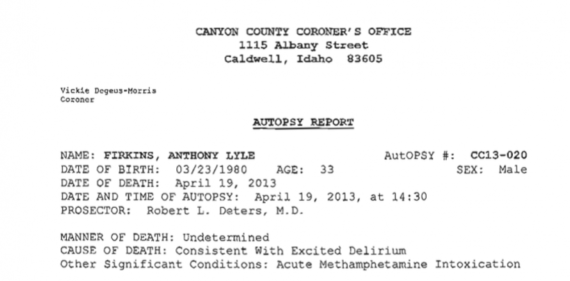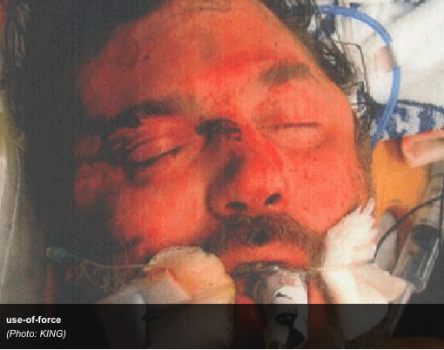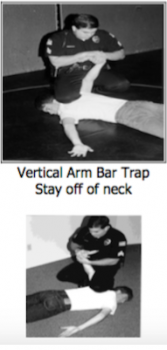
by Tana Ganeva
The following article first appeared on The Influence. Follow them on Twitter and Facebook.
Julie Cobio Firkins prayed and then walked into a room to watch her 33-year-old husband die. "The video that you're going to see is very sad," she remembers the officer warning her--twice--before playing footage from a police bodycam. But as the tape rolled, she had a different thought: "It was brutal, not sad."
Why were all those officers tasing her husband, over and over, while he lay under a trailer truck? And why, once they had him in handcuffs, didn't they help him more when he cried out that he couldn't breathe?
"If you're talking, you're breathing, dude," an officer said.
***
On a clear, mild night in April 2013, at just after three, an Idaho man named Bobby Muse called 911 because he thought he heard a woman screaming. Two Nampa County police officers drove to a neighborhood in Nampa known to police as a place where trouble happens.
But on their way to the call, officer Eric Duke noticed a guy driving a pickup truck with his lights off. Duke tried to alert him by flashing his own lights, but Anthony Firkins raced away in his truck, a move that might make more sense given his likely state of mind--he'd recently relapsed on meth. He'd agreed to get help, but put it off because the week before he ran into police, a grandfather he'd adored had died.
"He was high on meth and probably freaked out, getting chased by police," Julie says. He'd had at least one panic attack before. "The way I know him, he was probably like, 'Who are these guys? What are they doing?' I'm pretty sure he was just scared."
Anthony Firkins sped through the small town, blowing through red lights and stop signs. When his pickup hit some railway tracks, it skidded and spun down the road, crashing into a fence. He ran out, hopped onto the truck bed and jumped a fence into the lot of Pacific Steel & Recycling. He crawled under the axle of a truck trailer and that's where officers found him. Most of the police bodycam footage--The Influence obtained several videos--starts there.
"Taser taser taser!" an officer yells, as they run to block off both sides of the truck. The tasers start going off. Another yells, "Tase him again!"
An officer drags him out from under the trailer. The confusing footage shows a blur of limbs, handcuffs, a wooden baton. Tasers go off the entire time. "Slow it down guys!" a voice of reason cautions, once Anthony has been hauled from under the truck. A taser pops again--this time a direct hit to Anthony's bare side. They're knocking him (though not that hard) with a baton and then their fists, trying to get him in position to be cuffed.
The cops handcuff him and search his pockets. Breathing heavily, they then begin to calm down and mill around, collecting evidence. Over the next five minutes or so, they make small talk, sometimes punctuated by noises from Anthony and their responses.
At one point, Anthony yells loudly. Then he wails "help" a total of seven times. "Save me!" he cries.
"We just did, man," an officer replies. "You're good."
"Relax," one says. "Don't start getting froggy, dude!" another warns. "Don't get froggy!"
"Oh shit!" Anthony screams. "I can't breathe. I can't breathe. I can't breathe. Goddammit, I can't breathe. I promise. I can't fucking breathe. Help!"
"I'm going to die," he moans.
"You're not going to die," says one. "We got the medics coming in here, so you're ok."
He gets quiet. The officers start chatting about how dirty their uniforms are--one suggests his wife won't be pleased with the extra laundry. Minutes later, they notice that Anthony has stopped breathing.
A Baffling Cause of Death
"I can still hear his screams," says his wife, Julie.
His dad, Anthony Firkins Sr., got the call while driving for the trucking company where his son had also worked. He took on the unfathomably grim job of studying the autopsy photos. "Nobody should have to look at their child's brain, but I had to."
Everyone seemed at a loss as to why Anthony had died.
"He was young. He was healthy. They were digging for a reason," Julie says. Did he maybe have a heart condition, she says an officer asked her on the phone? He didn't.
Then the coroner reached a conclusion that made no sense to them: She said Anthony's cause of death was consistent with excited delirium (with acute meth intoxication as another significant condition). The manner of death--homicide, suicide, etc.--was undetermined.
His family had never heard of excited delirium. This was not a satisfying answer. "They were tasing him, beating him, not letting him breathe," Julie says. "Just to say that it was excited delirium, that's a cop out."
What Is Excited Delirium, and Does It Even Exist?
Excited delirium is a very strange thing. Coined in the mid-1980s by a Miami medical examiner named Charles Wetli to explain deaths that seemed linked to cocaine use (but not overdose), it reportedly makes sufferers erupt in bizarre, aggressive behavior that may end in sudden death.
Wetli thought excited delirium mostly afflicted young men with outsize coke habits, but he also proposed some highly dubious risk factors for women: a history of cocaine use and too much sex.
When the dead bodies of sex workers began turning up around Miami throughout the 1980s, baffling detectives, who could find no signs of struggle or clear cause of death, Dr. Wetli surmised that after years of crack use, just one sex act was enough to kill them off. The women, it turned out, had in fact been asphyxiated, most likely by a serial killer.
"You're talking about little girls on the street, and it's not too hard to asphyxiate them, especially when you have their backs on the ground and your weight on their abdomen," a pathology professor told the Los Angeles Times.
Ever since, there's been disagreement about what excited delirium is and what causes it--and whether it exists. Yet it's found its way into police training: Cops are widely taught that people in a state of excited delirium are out of their minds, have "superhuman strength," and are "impervious to pain."
It's "the difference between a Tyrannosaurus and a tabby cat. There's no subtlety about the intensity of energy, the physicality. It doesn't seem like you're dealing with anything human," expert William Everett is quoted saying in the Idaho Peace Officer Standards & Training lesson plan.
And medical examiners cite excited delirium as cause of death, even though it's not recognized by the American Medical Association or the DSM (the American College of Emergency Physicians does recognize it as a distinct medical condition).
Civil liberties advocates are highly skeptical of the idea that otherwise healthy people just drop dead in police custody for reasons that have nothing to do with the police. "There have been more empirically based reasons why someone might have expired that aren't investigated once excited delirium is raised," says Eric Balaban, senior staff counsel at the ACLU's National Prison Project. "In instances where it's been raised initially, once more inquiry has been done, they've often changed the cause of death."
Set against that are the cops who say they've witnessed it.
Police academy instructor Rick Bowen once showed up at a domestic violence call. He was "a very seasoned street cop" by then, he says, but this was like nothing he'd ever seen. "There was a long, violent struggle. He was almost animalistic; all of his actions were like that of a ... caged animal." Bowen says he would like to send the bill for his five knee surgeries to excited delirium deniers, tell them about the nightmares he had for years.
The man singlehandedly took on a squad of cops, Bowen says. "Then he was completely silent." He died right in front of him; if Bowen had known what excited delirium was at the time, he says, he could have gotten the man medical help before it was too late.
Captain Greg Meyer spent 30 years in the LAPD; the popularity of PCP in the '70s and '80s made life decidedly unpleasant for police. "One little white guy, an architecture student, fought six cops and woke up in the hospital with no memory of it," he says. Back then they didn't have a fancy medical term for it: "We just called it 'whacked out.'"
"Some people make excuses for them," Meyer says of drug users. "'Not their fault,' which is crap. They choose to take the drugs; they could die. C'est la vie!"
Theories that have been floated about how someone could die of excited delirium include: an extreme spike in body temperature, a sudden jolt of adrenaline or skeletal muscle breakdown.
Excited delirium skeptics acknowledge that aggression, confusion and strange behavior exist. Obviously, sometimes people do too many drugs and freak out, or have an underlying mental health problem that spirals into a psychotic episode. And it can be difficult to safely restrain someone in a mental health crisis, whether you call it excited delirium or not.
Where the two sides drastically part ways is in the idea that people are just dying from excited delirium. These deaths almost always seem to happen during encounters with police, skeptics point out. And there are many ways to die in police custody that aren't mysterious at all.
An Insidious Killer
Dr. Werner Spitz, a German forensic pathologist with black-rimmed eye glasses and a shock of white hair, has been involved in enough historic investigations and trials to thrill a conspiracy theorist: the assassinations of John F. Kennedy and Martin Luther King Jr.; OJ Simpson, Phil Spector, JonBenet Ramsey, Casey Anthony.
He says he's seen close to a hundred cases where excited delirium was cited as cause of death. He hasn't seen one where he came away convinced that that's what actually happened. "I fail to see where this is coming from, that excited delirium has become a very common reason for people to die," he says. Often, he finds a more straightforward explanation: suffocation through being restrained in a way that prevents breathing.
"Maybe they can breathe just a little bit or maybe they cannot breathe at all," Dr. Spitz says. "Occasionally ... an individual cannot breathe and they'll even scream, 'I cannot breathe.' If they breathe they'll be fine. If they don't, they'll be dead."
"It happens routinely," says Erik Heipt, a Seattle lawyer who litigates policy brutality cases for Budge & Heipt. "Someone is held in the prone position with multiple officers on their back, goes still, and dies underneath the weight."
"It's a vicious cycle where you have officers who are perceiving someone resisting," Heipt continues. "So they're pushing down on them to get them to stop resisting. They're underneath, having trouble breathing, so they're struggling harder. Police add more body weight. [The suspect] stops moving ... all of the sudden they look and the person's face is purple."
If they've been running, struggling, experiencing a mental health crisis or using certain drugs, compression and positional asphyxia become especially dangerous. Just when they might need to breathe more deeply, police action might make it harder to breathe, leading to hypoxia: a mismatch of oxygen needs to oxygen the body's getting. A sneaky killer.
"The process of hypoxia is insidious, and subjects might not exhibit any clear symptoms before they simply stop breathing," wrote Dr. Donald Reay. "Generally, it takes several minutes for significant hypoxia to occur, but it can happen more quickly if the subject has been violently active and is already out of breath."
Even after a person has stopped struggling, police might continue putting pressure on them, thinking they've just tired themselves out or stopped resisting, when really they've passed out. Later, officers might say the suspect had been trying to throw them off and run away.
"But that's not why he's rising," Dr. Spitz says. "When you cannot breathe, you fight for your life. And you only have one of those."
"You're killing me!"--Brian Torgerson
In 2010 Brian Torgerson, 45, opened his door to find two Seattle Police Department officers. His dad had called them because Brian, who was schizophrenic, had hit him, then got in his car and drove off. His parents hoped officers would get him help.
Brian and the officers chatted outside his door. But when they grabbed him, he locked his arms to his chest. They tussled and the cops called for backup. Officers from two precincts stormed up the stairs to Brian's apartment.
Despite witness testimony that Brian wasn't resisting, especially after he was handcuffed--unless you count his yelling "You're killing me!" pre-handcuffs--over the next 20 minutes multiple officers at a time sat on him or pressed down on him with their knees. They covered his head and neck in a spit hood, which became so drenched with his blood and vomit that it likely choked him further. They strapped him, facedown--and still wearing the spit hood--to a flat board, and then sat on and kneed him again, even though his hands and legs were bound to the board.
"I was concerned that the man might be having trouble breathing given the number of officers on top of him and the fact that he was on his stomach strapped to the board," a witness said. Brian lived but suffered severe, permanent brain damage.
Right after the incident, the department posted a version of events on their website: "The officers escorted the man down to the street where they were waiting for transportation to the hospital. While there, the man stopped breathing," reports the Seattle Times.http://www.seattletimes.com/seattle-news/fathers-lawsuit-blames-seattle-police-for-sons-injuries/
In court, the officers involved didn't exactly lie about what happened, but there were some peculiar omissions.
"The incident resulted in a "Help the Officer" radio broadcast. Officers responded from the (sic) both the West and East Precincts. The Seattle Fire department arrived and treated Torgerson for medical problems and a cut to the nose. He was subsequently transported to HMC," stated officer G. Leavitt, swiftly passing over the part where Torgerson was handcuffed, bleeding and vomiting, in a spit hood, with officers on his back.
"If there were a medal for withholding important information from a court of law, the defendants would win the gold." wrote lawyers for Torgerson's family in a legal brief. "From reading defendant's motion, for example, the Court would have no idea that for over 20 minutes after Brian Torgerson's hands were cuffed behind his back and his legs zip-tied together, multiple officers were on top of him--holding him in a prone (face down) position position by kneeling on his upper back, literally compressing him with enough body weight to suffocate him and stayed on top of him after noting he was no longer breathing."
Asphyxiation doesn't mark the body in any way, leaving no physical signs to make it obvious to coroners that someone died because they couldn't breathe ("It's not like CSI," Erik Heipt, who helped litigate the Torgerson case, helpfully notes). Circumstantial evidence, like video or witness testimony, is the only way to determine suffocation from compression as cause of death. It can be all too easy to bury what really happened, for example in the terse prose of a police report.
The city offered a $1.75 million settlement to end the Torgersons' case--apparently they weren't too confident in officers' defense that Brian's heart stopped due to excited delirium and that they'd used reasonable force.
Brian Torgerson in the hospital
Why Officers Often Don't Realize What They're Doing
Whenever an in-custody death of this kind doesn't implicate police there's no pressure on departments to change their training procedures. "That gives blanket permit to the police department to continue to do this," says Dr. Spitz. Instead of looking the thing straight in the face, calling it what it is."
In his experience it seems that a lot of officers don't realize how little weight it takes to suffocate someone. It's not just chest compression that does it; pressing down on the lower body can also be dangerous if it prevents the diaphragm from expanding.
When Kevin Colindres, an 18-year-old autistic man from Florida, died after an encounter with police, the medical examiner didn't understand why. So she asked officers to recreate the incident, with the officer who'd applied restraint taking Kevin's place.
Dr. Spitz says: "In less than one minute the officer that applied the restraint but was subject of restraint [in the experiment] ... he indicated to the restraining officer, "Get off of me right now. He said "I can't breathe. He very severely panicked under the restraints."
Better Guidance Is Out There
But there are best practices to avoid asphyxia in a person who's been restrained.
Police guidelines in other countries seem unequivocal. "Any body position that interferes with breathing can cause death," states a training manual used by police in Victoria, Canada. Officers are told to recognize risks such as the person saying they can't breathe, gurgling/gasping sounds, panic, prolonged resistance and "sudden tranquility." They must also avoid or at least utterly minimize the time spent in a prone restraint. And: "Do not sit or lean on the abdomen EVER."
The UK's College of Policing "authorized professional practice" sheet similarly warns officers of death risks if someone is positioned in a way that inhibits breathing and counsels: "the best management is de-escalation, avoiding prone restraint, restraining for the minimum amount of time, lying the detainee on their side and constant monitoring of vital signs."
And even in the US, a 1995 manual by the Department of Justice advised, "To help ensure subject safety and minimize the risk of sudden in-custody death, officers should learn to recognize factors contributing to positional asphyxia. Where possible, avoid the use of maximally prone restraint techniques (e.g., hogtying)." Other guidelines included "as soon as the suspect is handcuffed, get him off his stomach." The NYPD issues very similar advice.
Other professionals concur: "...we are trained to never put a patient face-down on the ground," wrote Marc E. Fitch, who's trained ER staff and mental health providers on crisis prevention techniques. He explains: "Face-down on the ground, the patient is often unable to expand his chest to take a breath. This condition is exacerbated by people piling on top of the patient in an effort to keep him or her down, the patient's weight and health conditions, and his or her stress level." Other risk factors include obesity and recent use of drugs like cocaine or meth.
But Instructions Are Often Less Helpful
The advice is sometimes muddied, however. For example, the basic training manual used in Idaho--where Anthony Firkins died--splits restraint instructions into three categories: compliant, unknown risk and high-risk handcuffing. It seems to suggest that prone handcuffing is the best strategy for a "high-risk" suspect: "Prone Handcuffing (The highlighted areas in each section emphasize the principle to be accomplished. The methods to accomplish it may vary depending on circumstances and environment. Control and officer safety are always primary considerations," and include the following illustration:
Yet the manual does embed a Wikipedia entry on positional asphyxia at the end, as well as Dr. Reay's paper on it. And in the section on excited delirium one of the 10 tips presented by an expert says to avoid the prone position during transport--as did a police bulletin distributed to Nampa sheriff's deputies in 2010. It seems like a confusing combination.
"Help Me, Grandma, I don't want to go"--Alonzo Ashley
On a boiling July day in 2011, Alonzo Ashley and his girlfriend were at Denver Zoo when Ashley got so sick from the heat that he threw up. He went to a water fountain to splash water on his head. When a security guard came up to him, he allegedly became hostile, although his girlfriend says he merely told the security guard to leave him alone. At that point, Ashley seemed to lose it. He chased after the security guard and pushed over some trash cans. Zoo officials called the police.
The first officer on the scene told him to sit. Ashley sat, but then got up and wandered away. More officers arrived and tried to take him down, tasing him in "drive stun" mode--a direct hit designed to cause pain--and punching him in the stomach. They tased him again. Officers would later note that Ashley seemed "extremely strong."
"Help me, Grandma, I don't want to go," the apparently confused Ashley cried out.
He was handcuffed, laid on his stomach, his legs folded in a figure-four lock--crossed and pressed towards his back. He threw up again. After a few minutes, Ashley stopped breathing and was pronounced dead in the hospital.
Alonzo Ashley
Later, one of the officers said that his sweating and apparent strength led him to conclude they had an excited delirium case on their hands. The trial documents note, "It is often impossible to control individuals experiencing excited delirium using traditional pain compliance techniques. Paradoxically, these individuals are physiologically more likely to die from a prolonged struggle, but also more likely to physically resist restraint."
This is a potentially lethal paradox, regardless of one's stance on excited delirium. Let's say that excited delirium exists and gives you superhuman strength and you can die from it. Or, let's say it's nonsense, but the symptoms associated with it have developed because of a mental health crisis or bad drug reaction (or in Ashley's case, possibly overheating). What are officers supposed to do to make sure the person, others in the area, and officers are safe?
Michael Brantley, a police instructor at the South Carolina Criminal Justice Academy, believes that excited delirium exists and that it can result in death on its own. He also doubts that aggressive police tactics are the best way to prevent that outcome. "I think a lot of it depends on situation. If you have someone already agitated because of the state they're in, to introduce pepper spray, a taser, a large group of officers, it can increase that anxiety [that's] already kicking up their system."
But Captain Greg Meyer think tasers are a godsend in their purported ability to incapacitate the excited delirium sufferer--and that the sooner they're under control, the sooner they can get medical help.
The science is still out on tasers, but it seems clear that their overuse can escalate an already fraught police encounter. In fact, lawsuits over sudden deaths in police custody have targeted manufacturer Taser International. The company, for its part, has not inspired confidence by avidly promoting the idea that "excited delirium" can be deadly on its own to police departments, even distributing a pithy note to share with bereaved families: "We regret the unfortunate loss of life. There are many cases where excited delirium caused by various mental disorders or medical conditions, that may or may not include drug use, can lead to a fatal conclusion."
Read more from The Influence:
Four Years Ago, a Young Black Woman Vanished From New York. What Happened to Stevie Bates?
The Anatomy of a Heroin Relapse
...and follow us on Facebook and Twitter.
On His Stomach--Anthony Firkins
Death associated with restraint asphyxia in police custody has been endlessly debated, with some experts (those favored by police departments) contending that it's unlikely that people die that way. Some researchers have concluded that you probably can't die like that; others that you can.
As Rick Bowen points out, no cop ever went to work hoping for a mysterious in-custody death on their watch. And police just don't get the right training to deal with mentally ill or otherwise distressed people--an oversight that far too often ends in fatal shootings. But many police practices and habits escalate situations that can and should be de-escalated.
Anthony Firkins' family wonders what might have been had officers handled things differently. He was tased six times (according to the Idaho Statesman's count).
It should be noted that once he was in cuffs, officers calmed down and tried to get him to relax; footage doesn't suggest multiple officers putting weight on his back for an extended period, like in the Brian Torgerson case (although the police cams don't pick up everything and it's pretty dark). The two officers, Joshua Krohn and Eric Duke, who spent the most time with Anthony after he'd been restrained tried to calm him down. "Just relax man. Take deep breaths, you're alright," said Krohn.
But other than short spells on his left side and then his right side--while officers searched his pockets, and a minute or so later--Anthony was handcuffed and down on his stomach, in the prone position that many training manuals advise against.
He was on his stomach when he repeatedly yelled that he couldn't breathe. The idea that people who are having trouble breathing can't talk appears to be a misconception--air can come out of you, even if there isn't enough coming in.
Anthony was prone when officer Duke put him in a figure four-figure leg lock, crossing his legs behind his back and pressing them against his back. He'd kicked back his legs once, but after that he stopped physically struggling or making much noise.
He was still on his stomach when officer Becky Doney--who later told investigators that he'd stopped fighting at that point, which video evidence confirms--placed him in a hobble restraint.
Anthony stayed prone until officer Garrett Tillet noticed that the "fine dust" on the ground under his face was no longer moving. He felt under his nose, and couldn't find his breath.
"Yeah he was breathing... and his breathing was shallow about 20 seconds earlier and then I took my hands off him." officer Krohn told the arriving EMTs.
Anthony had no pulse by the time the medics arrived. They took him to the ER where doctors tried to revive him, pumping his chest. They briefly brought back a pulse, but it didn't last. He was pronounced dead shortly after five in the morning.
***
In 2014, a Filer, Idaho officer shot and killed a black lab. The story was widely reported, the dead dog memorialized on a Facebook page with over 11,000 likes demanding that "Officer Hassani get out of Filer, Idaho." The Mayor and city council faced a recall campaign over the incident.
Julie Firkins couldn't understand why a dead dog got more attention than her dead husband.
Both she and Anthony Sr. still don't get why no one faced any consequences for Anthony's death, or why the family didn't even get an apology. It took Julie 10 months to even get access to one of the videos--the Chief of Police let her watch it, but only if she promised not to bring recording materials into the room (the Nampa police department declined to comment, noting that the statute of limitations hadn't expired).
Eventually, the family gave up on suing, because the amount of money they might have gotten in a lawsuit wouldn't have offset the money spent on lawyers and experts, and money is tight. Anthony left three kids behind, now aged 12, 8 and 6.
"We're talking about a human being's life," says Anthony Sr. "Three boys," he says of the kids. "I wish I could have filmed the funeral so [the police] could see their broken hearts."
Tana Ganeva is the deputy editor of The Influence. You can follow her on Twitter: @TanaGaneva.



